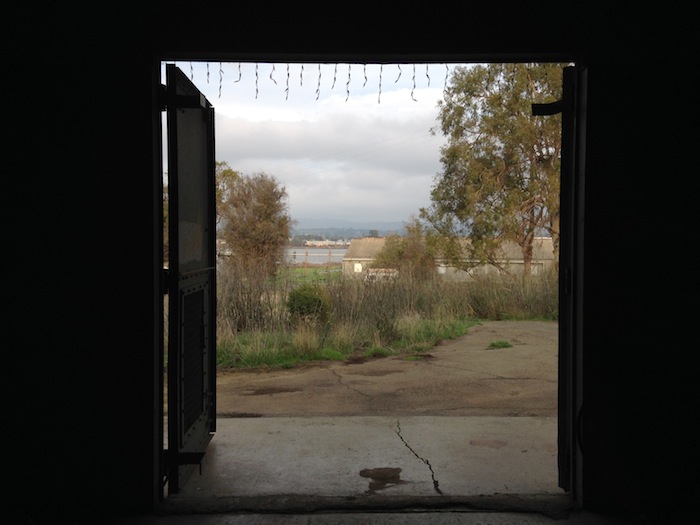
A few weeks ago we bolted north up the I-80 to check out some sound art being performed inside one of Mare Island’s old concrete munitions storage magazines leftover from World War II. The island (which is actually a peninsula), was established in 1852 by the Navy for ship repair, and later grew into the largest ship construction/repair facility in the world during World War II. Since 1996 the base on Mare has been mostly abandoned, and a small portion on the southern tip has been turned into a 215-acre heritage preserve that regularly gathers a motley crew of bird watchers, veterans, artists, wine tasters, historians, picnickers, photographers, and, of course, golfers.
The island itself quietly occupies a different sort of edge. The adjacent city of Vallejo went bankrupt in 2007, and has since seen waves of artists and other affluent people moving there as the region's larger gentrification forces relocate communities further and further away from San Francisco's exclusive core. In 2011, auteur filmmaker Paul Thomas Anderson used parts of Mare Island as locations for scenes in his brilliant World War II-era film The Master. There is a fascinating psycho-cultural interweaving that continues to find its way in and out of these bunkers. While birds singing on the Island's Shoreline Heritage Park have their own quiet fields now free of the Navy's industrial clamor, the bunkers inside echo with a mingling of old and new ghosts, as if they’re giant concrete ears listening to everything, capturing and recording in their own mysterious ways. Re:sound produced glimpses into a new ecology that can both conjure history without overly-recontextualizing it, and show what the bunker’s archive allows to flourish in history’s footprint.
Migration was the first of a set of installations and performances organized by Jen Boyd under the name Re:sound, “an experimental music series focusing on exploring the relationship between forgotten spaces and the natural environment.” And she couldn't have picked a better place. Mare today is an architectural litany of weedy bunkers, boarded up barracks, manicured officers' housing, hulking hangars and repurposed warehouses, idle cranes and disassembled dock infrastructure. But it is certainly not without life, nor without ghosts.
Standing in front of magazine A-168's bulletproof door, Jen says she’s “just fascinated by the spaces and the sounds here,” just as we have been, ever since we first began exploring Mare ourselves a couple of years ago. Jen has been “playing noise” and recording the sounds of nature for fifteen years. “I want to bring people closer to listening to things that are around them every day, but might not even hear, so … you know, to just appreciate what's around them.” Who wouldn't want to focus on listening and expanding their ears inside a giant empty bunker?
In fact, we might suggest that certain historic echoes here should never (and, in fact don't ever) fade from our listenability entirely. After the massive munitions blast at Port Chicago (just up the coast from Vallejo), in 1944, that killed over 300 sailors (considered the worst home-front disaster of the war), Mare Island was the place where hundreds of black sailors from a segregated unit barracked in Vallejo were detained for refusing to continue loading munitions onto ships bound for the Pacific. For roughly fifty sailors who didn't give in to Navy pressure and return to duty under unsafe conditions and draconian command, they were charged for mutiny, sentenced to fifteen years hard labor, and court-martialed. Mare Island also had a Navy brig—“Old 84”—that housed Navy and Marine personnel convicted of serious offenses. They farmed and did hard labor, and built the preserve's golf course in 1892.
It was quite fitting that inside the performance bunker there was an old golf cart for lounging on, but most people either brought their own collapsible chairs and blankets to sit on, or just milled about moving constantly to absorb the nuanced vectors of the bunker’s raw acoustics. The show itself was excellent; sliding footsteps, voices cast into various nooks, crannies, and corners of space, makeshift instruments and sculptures, vocal chord transformers, loop machines and laptops. It was at times the possessed soundtrack of a bunker going through an exorcism, and at others merely an amplification for an ecology that has long harbored in and around the bunkers for refuge. It was the music of old war architecture made into both loudspeaker and habitat.
Re:sound itself represents its own periphery within the frays of Mare. Jen told us that her and her partner are organizing this all on their own on a shoestring budget for now, with rented generators tucked in the tall grass, and with the help of donations. And there is something to be said for these sorts of hums emanating in the post-military pastures where military coffins are turned into staging grounds for moments of cultural autonomy, like self-powered listening stations tapping histories embedded in landscape with new forms that acoustically marble the past with present.
In the end, the ruins of Mare were given a spectral voice.
Photo by Joe Cantrell
Live performances included in the audio are by Kevin Corcoran & Jen Boyd; Jorge Bachmann & Michael Mersereau; Jim Haynes; Voicehandler; Joe Cantrell; and Gretchen Jude
